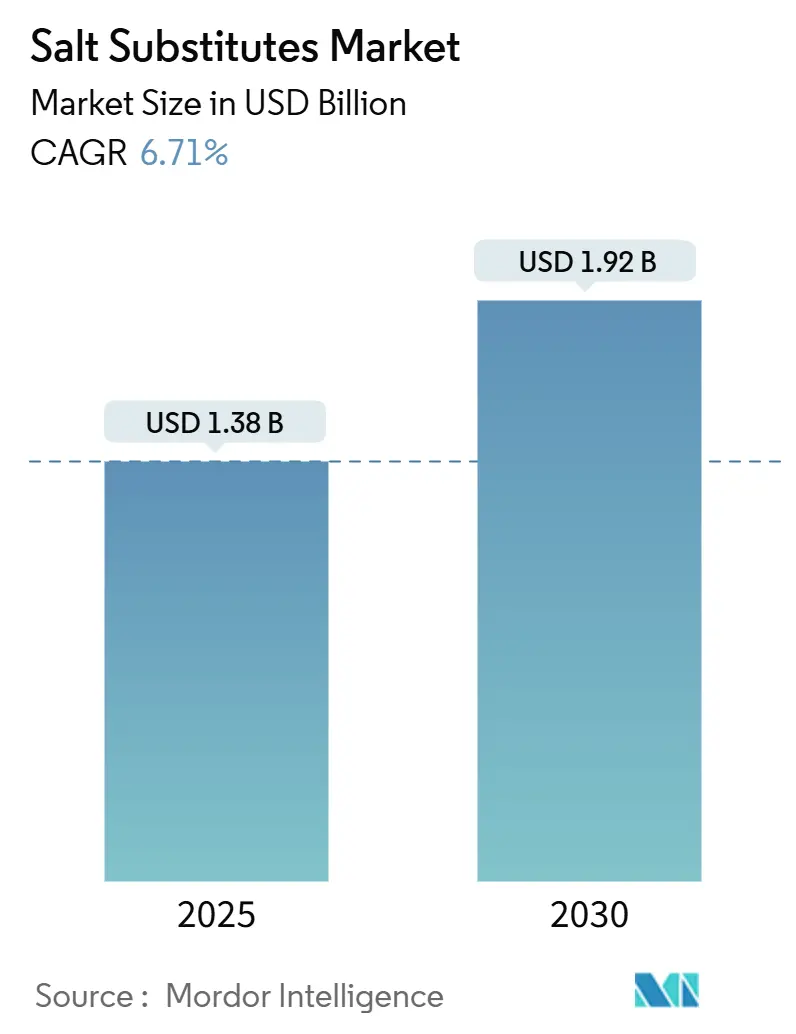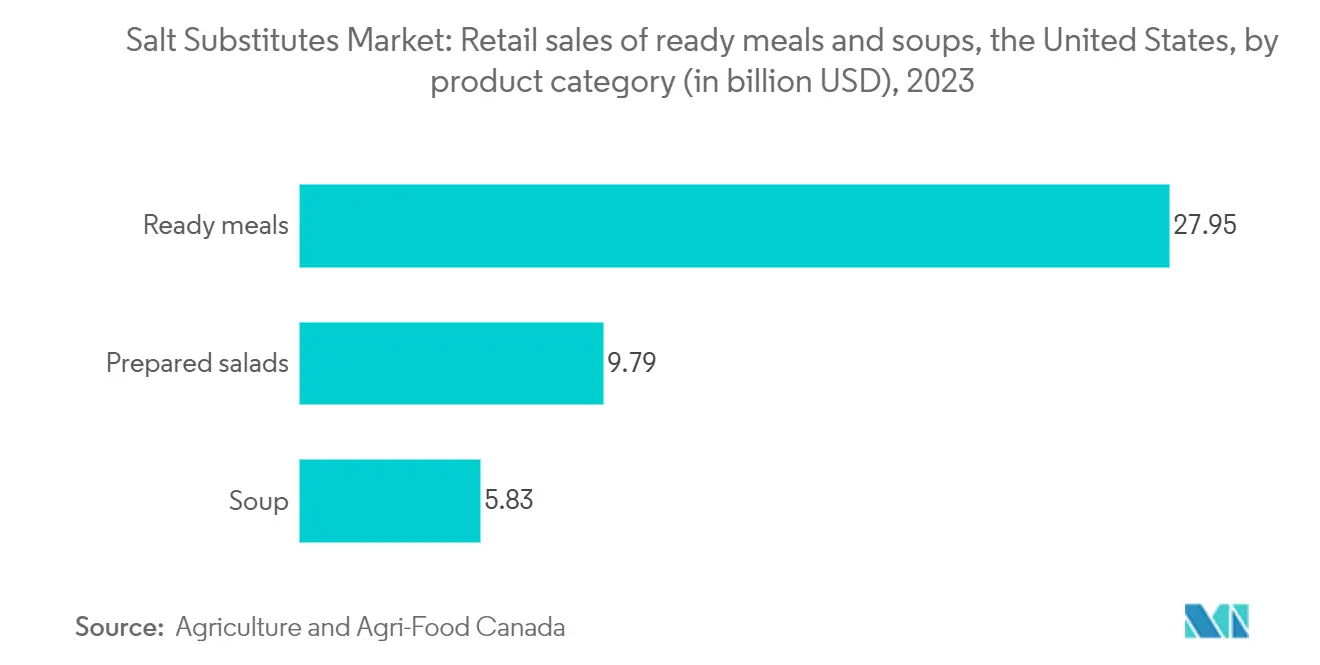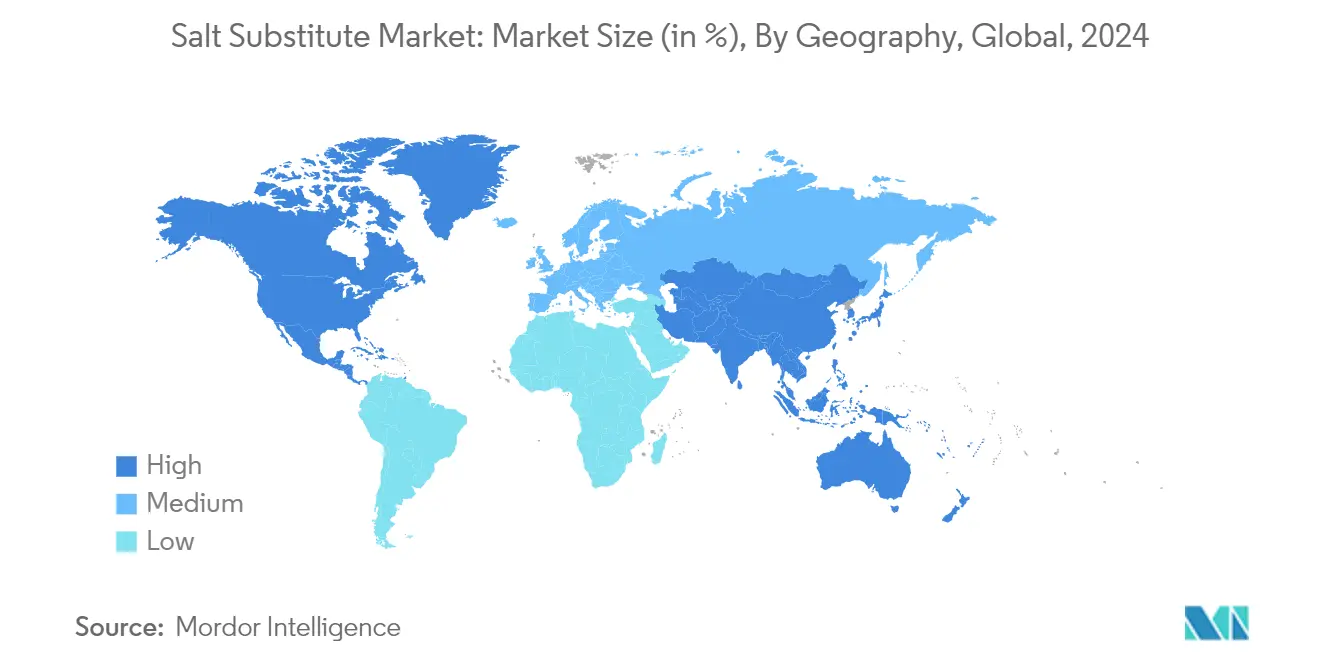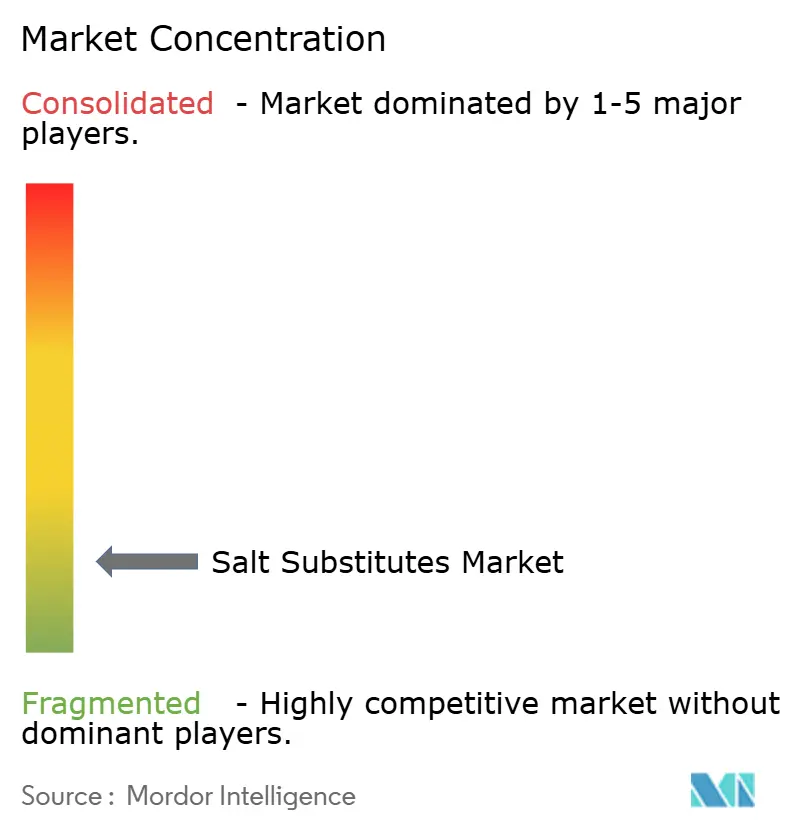Salt Substitutes Market Size and Share

Salt Substitutes Market Analysis by Mordor Intelligence
The Salt Substitutes Market size is estimated at USD 1.38 billion in 2025, and is expected to reach USD 1.92 billion by 2030, at a CAGR of 6.71% during the forecast period (2025-2030).
- The increasing awareness of health risks associated with high salt consumption drives the demand for salt alternatives. The combination of busy lifestyles and heightened health consciousness has led consumers to actively seek sodium reduction in their diets. Kosher salt substitutes have gained prominence due to their health benefits, including improved digestion through stomach acid production and maintenance of electrolyte balance for blood cell and vessel health.
- Salt substitutes are expanding their market presence through their nutritional benefits as functional food additives. Potassium chloride, for example, serves multiple functions under GRAS-approved usage, including flavor enhancement, nutritional supplementation, pH control, and stabilization in foods and beverages.
- Government initiatives worldwide are strengthening consumer health measures through collaboration with food and beverage manufacturers to reduce sodium content. Countries including the United States, Europe, the United Arab Emirates, and India have implemented stricter regulations on food sodium levels, compelling manufacturers to adopt appropriate salt alternatives while maintaining product taste.
- The market shows significant activity, with companies launching new products and expanding their presence. In August 2023, Ajinomoto (Malaysia) Berhad (AMB) launched AJIRISE UM and AJIRISE K. The AJIRISE series, a yeast extract-based product line, enhances savory sensations while maintaining original taste profiles. AJIRISE UM specifically delivers umami and kokumi flavors, particularly effective with spices and creamy components.
Global Salt Substitutes Market Trends and Insights
Salt Substitutes Gain Popularity in Soups, Salads, and Sauces
- Consumers are choosing salt substitutes in salads, soups, and sauces to reduce their sodium intake. High sodium consumption is linked to elevated blood pressure, cardiovascular problems, and hypertension. The World Health Organization identifies hypertension as the leading risk factor for cardiovascular diseases and global mortality, affecting 1.4 billion adults and causing 10.8 million deaths annually. According to the Centers for Disease Control and Prevention (CDC), in 2023, approximately 46 percent of adults in Mississippi, United States, had hypertension.
- Potassium chloride functions as the primary component in salt substitutes, providing a healthier alternative to sodium chloride. Potassium is an essential mineral that regulates blood pressure and maintains fluid balance. Higher potassium consumption combined with reduced sodium intake can improve cardiovascular health. Manufacturers reduce sodium content while preserving flavor by incorporating salt alternatives such as potassium chloride. Fleur de Sel has emerged as a common kosher salt substitute used in salads, soups, and other dishes.
- Salt substitutes enhance flavor profiles in dressings, soups, and sauces while lowering sodium content. These substitutes incorporate herbs, spices, and natural flavors that deliver savory and umami tastes. Manufacturers utilize these alternatives to maintain product flavor while meeting reduced sodium requirements. The rising adoption of salt substitutes in salads, soups, and sauces reflects increased health consciousness among consumers and an understanding of the health effects of sodium. This transition allows food manufacturers to develop healthier options that maintain taste quality. For instance, in April 2024, CJ CheilJedang introduced an extended line of reduced-sodium sauces and packaged soups, responding to the increasing demand for lighter alternatives.

Asia Pacific Markets Surge Amid Health Initiatives and Culinary Innovations
- China faces significant health challenges related to salt consumption, with 80% of salt intake coming from direct addition to food. According to WHO data, approximately 270 million Chinese individuals have hypertension, with only 13.8% maintaining proper control as of 2023. The reduction of salt intake presents a practical and effective approach to address rising blood pressure and prevent hypertension in the population.
- Japan's salt substitute market is evolving through the integration of sodium-reduction solutions that maintain taste quality. Companies are adopting alternatives like yeast extracts to meet health-conscious consumer demands. Angel Yeast demonstrated this market direction at the IFIA Food Show in May 2024, presenting yeast extract solutions for sodium reduction in processed foods, seasonings, and condiments. These innovations support Japan's expanding green food market and health-focused dietary trends.
- India's government has implemented measures to reduce salt consumption through salt substitutes. The country aims to decrease salt intake by 30% by 2025. The Food Safety and Standards Authority of India (FSSAI) implements the 'Eat Right India' movement during the forecasted period to transform the national food system. The government's "Aaj Se Thoda Kam" social media campaign, featuring Bollywood actor Rajkummar Rao, promotes reduced consumption of salt, sugar, and fat.
- Australia's salt consumption remains a significant health concern, with average intake at twice the recommended levels. According to the Grattan Institute's October 2023 report, salt-related illnesses result in 2,500 deaths annually and healthcare costs of USD 10 billion. The report indicates that reducing salt consumption could extend Australians' collective lifespan by 36,000 years over the next two decades.

Competitive Landscape
The salt substitutes market demonstrates moderate competition due to the significant presence of local players. Companies maintain their competitive positions through product innovation, geographical expansion, strategic partnerships, and sustainable practices. Market players develop customized solutions to address the specific requirements of food manufacturers and health-conscious consumers. Several companies are expanding their production capacities to strengthen their market presence and improve product availability globally. Companies implement various strategies, including facility expansion and adherence to food safety standards. Key market participants include Cargill Incorporated, Kerry Group, Ajinomoto Co., Inc., Tate & Lyle PLC, and DSM-Firmenich.
Salt Substitutes Industry Leaders
Cargill Inc
Ajinomoto Co Inc
Kerry Group PLC
DSM - Firmenich
Tate & Lyle PLC
- *Disclaimer: Major Players sorted in no particular order

Recent Industry Developments
- December 2024: Revye established a distribution partnership with Lallemand Bio-Ingredients for the North American market. The agreement makes Lallemand the exclusive distributor for Revye's products in the United States, Canada, and Mexico. The partnership also includes a supply agreement where Revye sources essential raw materials from Lallemand.
- November 2024: Corbion upgraded its AI-based Listeria control model by incorporating dynamic temperature modeling and deep-chill simulation capabilities. These improvements help food manufacturers enhance their food safety protocols and reduce product development time.
- October 2024: Lesaffre acquired a controlling interest in Biorigin, a Zilor subsidiary specializing in yeast derivative products. The acquisition aims to expand Lesaffre's production capacity for yeast derivatives used in savory ingredients.
Global Salt Substitutes Market Report Scope
Salt substitutes are low-sodium alternatives to edible salt intended to prevent high blood pressure and cardiovascular disease caused by high sodium chloride intake.
The global salt substitute market is segmented by type, application, and geography. The type segment includes mineral salts, amino acids, yeast extracts, hydrolyzed vegetable protein, and other variants. Applications span across bakery and confectionery, snacks, meat and poultry, beverages, soups, salads, sauces and dressings, and other food products. Also, the study analyzes the salt substitutes market in emerging and established markets across the world, including North America, Europe, Asia-Pacific, South America, and Middle East and Africa.
The market sizing has been done in value terms in USD for all the abovementioned segments.
| Mineral Salts |
| Amino Acids |
| Yeast Extracts |
| Hydrolyzed Vegetable Protein |
| Other Types |
| Bakery and Confectionery |
| Snacks |
| Meat and Poultry |
| Beverages |
| Soups, Salads, Sauces, and Dressings |
| Other Applications |
| North America | United States |
| Canada | |
| Mexico | |
| Rest of North America | |
| Europe | United Kingdom |
| Germany | |
| France | |
| Russia | |
| Italy | |
| Spain | |
| Rest of Europe | |
| Asia-Pacific | India |
| China | |
| Japan | |
| Australia | |
| Rest of Asia-Pacific | |
| South America | Brazil |
| Argentina | |
| Rest of South America | |
| Middle East and Africa | South Africa |
| Saudi Arabia | |
| Rest of Middle East and Africa |
| Type | Mineral Salts | |
| Amino Acids | ||
| Yeast Extracts | ||
| Hydrolyzed Vegetable Protein | ||
| Other Types | ||
| Application | Bakery and Confectionery | |
| Snacks | ||
| Meat and Poultry | ||
| Beverages | ||
| Soups, Salads, Sauces, and Dressings | ||
| Other Applications | ||
| Geography | North America | United States |
| Canada | ||
| Mexico | ||
| Rest of North America | ||
| Europe | United Kingdom | |
| Germany | ||
| France | ||
| Russia | ||
| Italy | ||
| Spain | ||
| Rest of Europe | ||
| Asia-Pacific | India | |
| China | ||
| Japan | ||
| Australia | ||
| Rest of Asia-Pacific | ||
| South America | Brazil | |
| Argentina | ||
| Rest of South America | ||
| Middle East and Africa | South Africa | |
| Saudi Arabia | ||
| Rest of Middle East and Africa | ||
Key Questions Answered in the Report
How big is the Salt Substitutes Market?
The Salt Substitutes Market size is expected to reach USD 1.38 billion in 2025 and grow at a CAGR of 6.71% to reach USD 1.92 billion by 2030.
What is the current Salt Substitutes Market size?
In 2025, the Salt Substitutes Market size is expected to reach USD 1.38 billion.
Who are the key players in Salt Substitutes Market?
Cargill Inc, Ajinomoto Co Inc, Kerry Group PLC, DSM - Firmenich and Tate & Lyle PLC are the major companies operating in the Salt Substitutes Market.
Which is the fastest growing region in Salt Substitutes Market?
Asia Pacific is estimated to grow at the highest CAGR over the forecast period (2025-2030).
Which region has the biggest share in Salt Substitutes Market?
In 2025, the Asia Pacific accounts for the largest market share in Salt Substitutes Market.
What years does this Salt Substitutes Market cover, and what was the market size in 2024?
In 2024, the Salt Substitutes Market size was estimated at USD 1.29 billion. The report covers the Salt Substitutes Market historical market size for years: 2020, 2021, 2022, 2023 and 2024. The report also forecasts the Salt Substitutes Market size for years: 2025, 2026, 2027, 2028, 2029 and 2030.
Page last updated on:
Salt Substitutes Market Report
The report on the Global Salt Substitutes Market provides a comprehensive industry analysis, offering insights into market segmentation by type and application, as well as geographical distribution. The market forecast indicates a positive market growth, driven by various market trends and the increasing demand for healthier food alternatives. The industry overview highlights the key market leaders and their contributions to the market value.
The market data within the report reveals significant market size and market share for different types of salt substitutes, including mineral salts, amino acids, yeast extracts, and hydrolyzed vegetable protein. The industry research covers various applications such as bakery and confectionery, snacks, meat and poultry, beverages, soups, salads, sauces, and dressings.
The market outlook suggests robust industry sales and a favorable industry outlook for the forecast period. Detailed industry information and industry statistics are provided, emphasizing the market's potential for growth and expansion. The report also includes market predictions and a thorough market review, ensuring that stakeholders have access to critical industry trends and market analysis.
For those seeking more detailed insights, the report example and report PDF are available for download. This comprehensive industry report is essential for research companies and professionals seeking to understand the dynamics of the salt substitutes market.
.webp)


